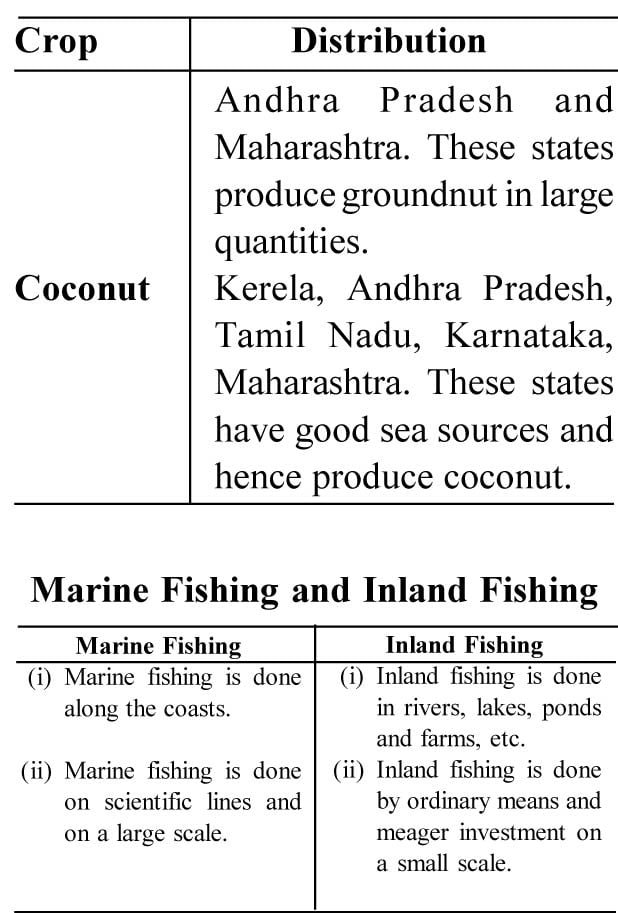Importance of Agriculture in Indian Economy
Agriculture has a very big role in India’s economy due to the following factors :
(i) About 60% of Indian population derive their livelihood from agriculture.
(ii) India is a country which has second highest population in the world. Agriculture provides food to this huge population and very large number of cattles.
(iii) Agro based industries are dependent on the raw materials provided by agriculture.
(iv) About 45% of India’s National income is obtained from agricultral products.
Types of Agriculture in India
(i) Subsistence Farming : In this farming, farmers work hard to grow enough food to survive only. Nothing is left to sell in the market.
(ii) Mixed Farming : In mixed farming as the name indicates, cultivation of crops and rearing of animals are done at the same time on the same farm.
(iii) Shifting Cultivation : This type of farming is carried on in jungles of north-eastern part of India. An area of land is cleared for cultivation. As the yield decreases after two or three years, the area is abandoned and a fresh area is created.
(iv) Extensive Farming : This agriculture is done in countries where population is small and land is enough. Here, per acre yield is low but it is in surplus due to less population. Machines are used for agriculture.
(v) Intensive Farming : This type of farming is done in countries where the size of population is big but land is less. Every year two or three crops are grown due to the demand of food for the big population. Manual labour is used for doing agriculture.
(vi) Plantation Agriculture : In plantation trees or bushes are planted on huge lands. A single crop like rubber, sugarcane, coffee, tea or banana is grown. These crop items are mainly exported.
Problems of Indian Agriculture
The low agriculture output is mainly due to several difficulties faced by our farmers.
(i) In Indian agriculture mainly a large manual labour is employed to work on farms. They grow just enough food for the needs of the family and small amount is left for marketing.
(ii) A major part of the Indian soil has been under plough for the last 4000 or 5000 years.
(iii) The main cause of soil erosion is due to deforestation, overgrazing and heavy rainfall.
(iv) Divisions of land have led to fragmentation. The size of land holding is very small and uneconomic.
(v) In our country the farmers are poor, illiterate and ignorant. They have primitive tools and old methods.
(vi) They do not have financial credit and investment.
(vii) Our farmers do not have good seeds, fertilizers and improved technology.
(viii) Facilities of irrigation are still on the mercy of nature.
(ix) There is no security to farmers against crop failure or loss caused by nature.
Different Crop Seasons in India
India has following three crop seasons :
(i) Rabi : Rabi crop starts after the rainy season. Sowing begins in September-October and harvesting takes place in February-March. Wheat, barley, pulses and some oil seeds like mustard are grown in the rabi crop.
(ii) Kharif : The kharif crop starts with the begining of the monsoons in June-July and harvesting takes place after the retreat of monsoon in September-October. Rice, maize, millets, groundnuts, cotton and jute are grown in the Kharif crop.
(iii) Zayad : This crop remains till April, May and June. Products are mainly watermelon, vegetables and fruits.
Green Revolution
Meaning and Impact : The revolution in agricultural productivity of cereals has been in the period 1965 to 1970 mainly as a result of introduction of high yielding varieties of wheat and rice and use of fertilzers, machines and irrigation, etc. This period has been called as green revolution.
Impact
(i) India has become self sufficient in food production due to green revolution. The import of food grains was stopped.
(ii) This saved our precious foreign exchange and also made us self-reliant.
(iii) Green revolution has been mainly beneficial to rich farmers because it involved a lot of investment. Poor farmers could not be benefited from this technology because they could not afford investment.
(iv) The income distribution was made unequal by green revolution. It also made rich farmers more rich.
A Study of some Medicinal Plants of India
India has been very famous all over the world for the spices that are grown here. The spices are also used in medicines. India produces black pepper, chillies, ginger and cardamom. These spices are grown in a constant high temperature and a very heavy rainfall. Thus, the production of spices is confined mainly to the Malabar Coast of Kerala and Karnataka where temperature is constant and rainfall is high.
Medicinal (Drug) Plants : Indian forests are rich to have medicinal herbs, shrubs and trees. It is estimated that there number is over 4,000 species. The Eastern and Western Himalayas and the Nilgiris are known as the source of many such plants.
The Central Drug Research Institute in Lucknow is carrying on extensive research work on Indian medicinal plants. The Medicinal Plants Committee of Government of West Bengal have started cultivation of certain very valuable medicinal plants at Rangpo in Darjeeling on experimental basis. Some of these plants are : Ipecac (Psychotria), Rauwolfia, Nux-vomica (Strychnos, nux vomie), Cinchona, Deadly nightshade (Atrop, belladona) etc.
Food Crops of India
Rice (Kharif) : Northern planes, deltas of Krishna, Cavery, Mahanadi and Godavari, U.P. Andhra Pradesh, Punjab, Bihar, T.N. produce large quantities of rice.
Wheat (Rabi) : U.P. Haryana, Punjab, M.P. Bihar, Rajasthan grow wheat in Rabi crop.
Millets—Jowar, Bajra, Ragi (Kharif) : These grains grown in all states of India except Bihar, Assam, W. Bengal as Kharif crop.
Maize (Kharif) : U.P. Punjab, M.P. Bihar and Haryana are main states which grow maize as Kharif crop.
Pulses—Gram, Arhar, Moong Masur (Kharif) : U.P. Punjab, Haryana, Bihar, Andhra Pradesh, Maharashtra, Bihar, M.P., TN. produce these crops as Kharif crop.






